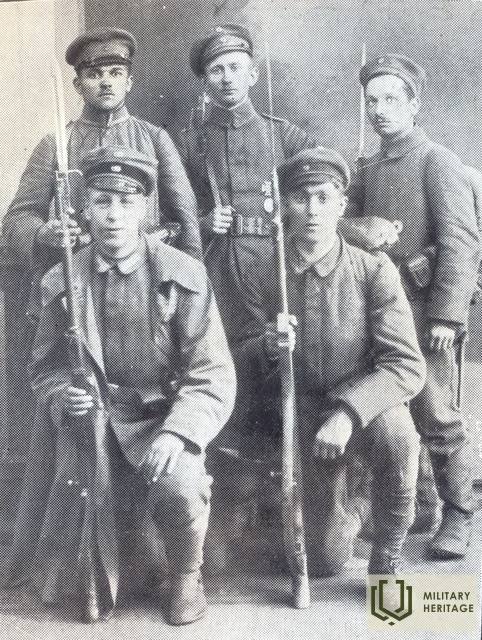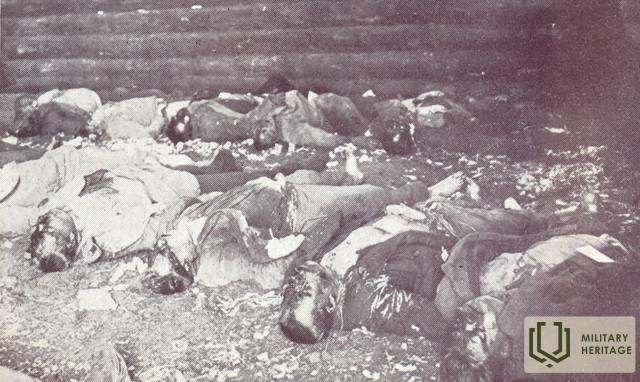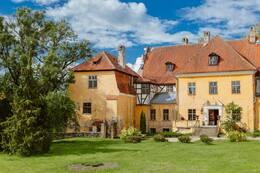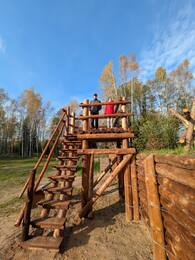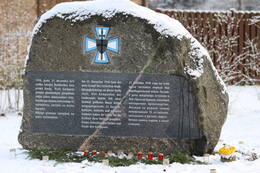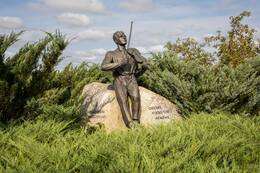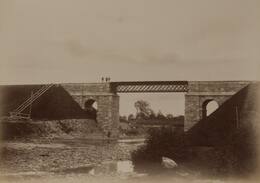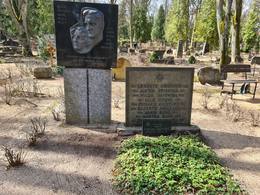Landesveras. Baltijos landesveras
I Nepriklausomybės karai
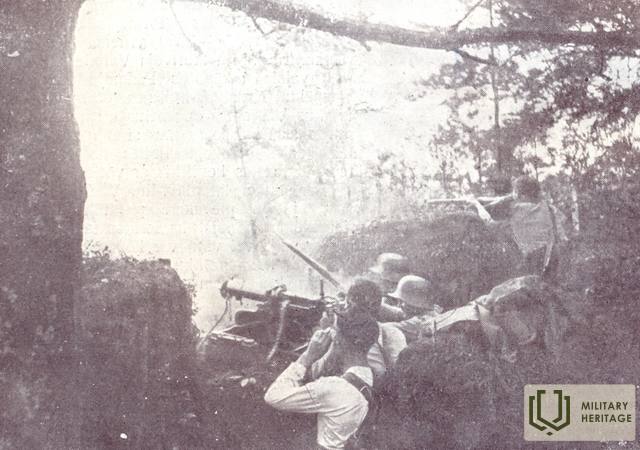
Landesveras. Baltijos landesveras (vok. Baltische Landeswehr, rus. Балтийский ландесвер, angl. Baltic Land Defence, Baltic Territorial Army, Baltic Home Guard)
Baltijos landesveras buvo vokiečių okupuotų Baltijos provincijų gyventojų savigynos struktūra, kurios parengiamieji darbai prasidėjo 1918 m. ankstyvą rudenį, tačiau lapkričio antroje pusėje buvo įtrauktas į naujai įkurtos Latvijos Respublikos ginkluotąsias pajėgas – Latvijos žemės gvardiją (vok. die Lettländische Landeswehr), šnekamojoje kalboje vadinamą „Landesveru“ arba „Baltijos landesveru“.
Daugiatautė (baltiečių vokiečiai, latviai, rusai) „Latvijos nacionalinė gvardija“, remiama Vokietijos karinės paramos, tapo Latvijos ginkluotosiomis pajėgomis. Administraciniu požiūriu ji buvo pavaldi Latvijos gynybos ministrui Jāniui Zālīčiui, tačiau logistikos ir kariniu požiūriu – Vokietijos okupacinių pajėgų vadovybei. Latvijos vyriausybės ir Vokietijos atstovo Augusto Vinnigo susitarimas numatė Nacionalinės gvardijos formavimą savanoriškais pagrindais iš 18 Latvijos, 7 Vokietijos ir vienos Rusijos kuopos, Nacionalinės gvardijos vadas pagal pirminį planą turėjo būti neutralios šalies (Švedijos) atstovas, tačiau tai neįvyko. Jau lapkričio pabaigoje Vinnigas iš išvykstančių Vokietijos kariuomenės karių buvo suformavęs Geležinę brigadą (vėliau Geležinė divizija), kurios kariai pagal gruodžio mėnesio susitarimą turėjo galimybę gauti Latvijos pilietybę ir žemę.
Vokiečiai ir baltiečiai kariuomenę ir toliau vadino Baltijos landesveru, o ne Latvijos landesveru. Latvijos kuopos, kurios pradėjo formuotis Landesvero sudėtyje, pavadinimus gavo pagal formavimo vietos (Ryga, Cėsys, Jelgava, Latgala) arba sudėties (karininkas, studentas) pavadinimą. Latvijos dalinių vadu buvo paskirtas pulkininkas leitenantas Oskaras Kalpaksas.
Vasario pradžioje į Liepoją atvyko generolas Rüdigeris fon der Golcas. Jis buvo paskirtas Vokietijos ginkluotųjų pajėgų (įskaitant Baltijos landesverą ir Geležinę diviziją) vadu Kurše ir Šiaurės Lietuvoje, taip pat Liepojos gubernatoriumi. 1919 m. balandžio 16 d. Golcui pavaldūs kariuomenės daliniai Liepojoje įvykdė perversmą prieš Latvijos laikinąją vyriausybę.
Į Baltijos landesverą susivieniję baltiečiai įvairiais Nepriklausomybės karo etapais palaikė Latvijos Liaudies Tarybos įsteigtą Laikinąją vyriausybę, vadovaujamą Karlo Ulmanio, ir kovojo prieš ją, kai stojo neteisėtos Andrijevo Niedros vyriausybės pusėn. Jei iš pradžių tiek vokiečių, tiek latvių daliniai turėjo bendrą tikslą – išlaisvinti Latviją nuo bolševikų, tai po Rygos išlaisvinimo 1919 m. gegužę landesvero ir vokiečių Geležinės divizijos karo veiksmai buvo nukreipti ne prieš bolševikus, o prieš Šiaurės Latvijos kariuomenę, ištikimą teisėtai Latvijos Laikinajai vyriausybei ir Estijos armijai. Po Cėsių mūšių, kuriuose buvo nugalėti landesveras ir Geležinė divizija, Latvijos valstybei ištikimi landesvero daliniai tęsė kovą su bolševikais. 1920 m. kovo 30 d. landesveras buvo pertvarkytas į 13-ąjį Tukumo pėstininkų pulką ir įtrauktas į Kuržemės diviziją. 1922 m. balandžio 1 d. pulkas buvo išformuotas, o kareiviai prijungti prie 7-ojo Siguldos pėstininkų pulko.
Žinomiausi Landesvero vadai buvo Alfredas Fletcheris (1919 m. vasario 1 d. – 1919 m. liepos 12 d.) ir Haroldas Alexanderis (1919 m. liepos 12 d. – 1920 m. vasario 18 d.).
Daugiau informacijos šaltinių
Ērikas Jėkabsonsas. Latvijos nepriklausomybės karas. Latvijos laikinosios vyriausybės ir jos ginkluotųjų pajėgų kova už Latvijos nepriklausomybę nuo 1918 m. lapkričio 18 d. iki 1920 m. rugpjūčio 11 d. – Nacionalinė enciklopedija: https://enciklopedija.lv/skirklis/22216-Latvijas-Neatkar%C4%ABbas-kar%C5%A1
Kova už laisvę: Latvijos nepriklausomybės karas (1918–1920 m.) Latvijos valstybinio istorijos archyvo dokumentuose, 1 dalis, 1918 m. lapkričio 18 d. – 1919 m. balandžio 16 d., sudar. Ē. Jēkabsons ir J. Šiliņš, Ryga, Latvijos nacionalinis archyvas, 2019 m.
„Kova už laisvę: Latvijos nepriklausomybės karas (1918–1920 m.) Latvijos valstybinio istorijos archyvo dokumentuose“, 2 dalis. 1919 m. balandžio 16 d. – liepos 10 d., sudar. Ē. Jēkabsons ir J. Šiliņš, Ryga, Latvijos nacionalinis archyvas, 2019.
Latvijos laisvės kova (žr. literatūrą ir išorines nuorodas). Vikipedijos puslapis: https://lv.wikipedia.org/wiki/Latvijas_br%C4%ABv%C4%ABbas_c%C4%AB%C5%86as
Susijusi laiko juosta
Susijusios vietos
Paminklas skirtas atminti Carnikaviečius, kuriuos 1919 m. sušaudė Landesveras.
Įsikūręs Carnikavos parko pietvakariniame kampe, Jūras ir Nākotnes gatvių sankryžoje, tarp dviejų ąžuolų.
Granitinis paminklas 12 Carnikavos gyventojų, kuriuos 1919 metų pavasarį nužudė vokiečių landesvero daliniai už tai, kad jie, kaip įtariama, lankėsi pas „raudonąją grupę“.
Lielstraupės pilis
Lielstraupės pilis yra Straupės miesto centre. Pilis atvira lankytojams ir siūlo kelionę per šimtmečius bei orientacinį važiavimą pilies labirintais. Cėsių mūšių metu Lielstraupės pilyje buvo įsikūręs Paulo Ludwigo Ewaldo von Kleisto Geležinės divizijos (vok. Eiserne divizija) kovinės grupės vadas. Mūšių metu pilį aplankė majoras Josefas Bischoffas, kapitonas Heinzas Guderianas ir kiti. Pilis buvo panaudota koordinuoti puolimą Stalbės kryptimi birželio 21–22 d. Geležinė divizija buvo vokiečių samdinių karinė jėga Latvijos nepriklausomybės karo metu, suformuota iš demobilizuotos Vokietijos imperijos 8-osios armijos karių ir savanorių samdinių. 1919 m. tai buvo geriausiai žinoma Vokietijos laisvojo korpuso dalis ir viena geriausiai parengtų bei labiausiai kovai pasirengusių karinių pajėgų Baltijos šalyse. Sovietmečiu, nuo 1949 iki 1959 m., iš dvaro pilies veikė Lielstraupės mašinų-traktorių stoties administracija. Tuo metu pilyje taip pat buvo įrengtos mokymo salės ir bendrabučiai traktorininkams, o buvusiame dvaro arklidėje buvo įrengtos dirbtuvės. Nuo 1963 iki 2018 m. pilį valdė medicinos įstaigos, o apie Straupės narkologinę ligoninę Latvijoje sakoma, kad ji „net gydo sienas“.
Kalėdų mūšių muziejus
Muziejus, įsikūręs sodyboje „Mangaļi“ Jelgavos apylinkėse, Valgundės seniūnijoje, yra Latvijos karo muziejaus filialas. Jis atidarytas 2005 m. toje vietoje, kurioje per Pirmąjį pasaulinį karą vyko Kalėdų mūšiai. Šiose vietose iki šiol tebėra išlikę išskirtiniai Pirmojo pasaulinio karo įtvirtinimai. Kalėdų mūšių muziejaus ekspozicija yra įrengta autentiškoje vietoje po atviru dangumi. Čia galima pamatyti rekonstruotą įtvirtinimų sistemos fragmentą – lauko slėptuvę ir dalį pirmosios vokiečių gynybos linijos, vadinamos „vokiečių pyli mu“. Tai vienintelis tokio pobūdžio objektas Baltijos šalyse. Kalėdų mūšiai – vienas žinomiausių ir dramatiškiausių Pirmojo pasaulinio karo įvykių Latvijoje. Jie užima ypatingą vietą latvių karo ir kultūros istorijoje. Intensyvūs mūšiai truko šešias dienos ir pareikalavo daug aukų. Šie įvykiai dažniausiai siejami su latvių šaulių puolimu prieš Vokietijos kariuomenę, vykusiu ypač atšiauriomis ir nepalankiomis žiemos sąlygomis. Tai buvo pirmas kartas, kai didelio masto puolimas vyko be artilerijos palaikymo.
Šiuo metu muziejuje eksponuojami mūšių vietose rasti radiniai. Vidaus ekspozicija lankoma nustatytu laiku, o po atviru dangumi esančių įtvirtinimų ekspoziciją galima apžiūrėti kiekvieną dieną. Apylinkėse sudaryti turistiniai maršrutai ir įrengti pažintiniai takai.
Paminklas pirmajam mūšiui už Latvijos nepriklausomybę
Adresas: Inčukalns, Atmodas g. 2.
2016 m. liepos 3 d. buvo atidengtas paminklas pirmajam mūšiui už Latvijos nepriklausomybę, skirtas Latvijos landesverui (Die Lettländische Landeswehr), kuriame vietos baltų vokiečiai, rusai ir latviai, tuo metu buvę abiejų pusių daliniuose, gynė naujai įkurtą valstybę nuo bolševikų Raudonosios Armijos. Brolių kapų komiteto pirmininkas Eiženas Upmanis tuo metu padarė išvadą, kad tai galėtų būti pirmasis paminklas jungtinėms Latvijos ir Baltijos vokiečių pajėgoms mūšio memorialuose už kapinių ribų. Tuo metu Latvijos landesvero latvių dalinių vadu buvo paskirtas pulkininkas leitenantas Oskaras Kalpaksas, iš kurio dalinių Laisvės kovų metu išaugo ir susiformavo vėlesnė Latvijos armija.
1918 m. visa dabartinės Latvijos teritorija pateko į Vokietijos imperijos ir jos kariuomenės rankas. Tačiau 1918 m. vasaros pabaigoje ir rudenį padėtis ėmė sparčiai keistis prieš Vokietiją ir tapo aišku, kad tik laiko klausimas, kada Vokietija bus priversta pripažinti pralaimėjimą Pirmajame pasauliniame kare. Rusijos imperija, kurios dalimi Latvija buvo iki Pirmojo pasaulinio karo, nustojo egzistuoti anksčiau, po 1917 m. vasario ir spalio revoliucijų. 1918 m. lapkričio 18 d. buvo paskelbta Latvijos Respublika. Vokietijos kariuomenė, kuri po 1918 m. lapkričio 11 d. paliaubų su Antantės valstybėmis buvo dislokuota Latvijos teritorijoje, nebebuvo motyvuota tolesniems karo veiksmams, ir dauguma jos kareivių tiesiog norėjo grįžti į tėvynę.
Tokiomis aplinkybėmis buvo akivaizdu, kad Latvijos gynyba pirmiausia priklausė nuo pačių Latvijos gyventojų suformuotos nacionalinės gvardijos. Iš pradžių, dėl savo išsilavinimo ir santykinai didesnio gebėjimo savarankiškai organizuotis, didžiausią iniciatyvą formuojant tokią nacionalinę gvardiją rodė Latvijoje gyvenantys Baltijos vokiečiai. Į nacionalinę gvardiją įstojo ir Rusijos kareiviai. Siekdama užtikrinti nacionalinės gvardijos aprūpinimą uniformomis, ginklais ir kitais reikalingais ištekliais, Latvijos laikinoji vyriausybė 1918 m. gruodžio 7 d. sudarė susitarimą su Vokietijos atstovu Augustu Vinnigu, numatantį nacionalinės gvardijos aprūpinimą iš Latvijos teritorijoje esančių Vokietijos armijos rezervų. Šiame susitarime, be kita ko, buvo nurodyta, kad ši nacionalinė gvardija, oficialiai vadinama „Latvijas zemessardze“ arba vokiškai „die Lettländische Landeswehr“, bus Latvijos Respublikos ginkluotosios pajėgos.
Latvijos nacionalinė gvardija susidūrė su dviem Latvijos raudonųjų šaulių pulkais (t. y. maždaug 2000–3000 karių), kurie anksčiau buvo patyrę Pirmajame pasauliniame kare ir Rusijos pilietiniame kare. Nepaisant Raudonosios armijos patirties ir skaitinės persvaros, Latvijos nacionalinė gvardija dvi dienas laikė Inčukalną įnirtingose kovose, kol galiausiai 1919 m. sausio 1 d. vakarą, norėdama išvengti apsupties, buvo priversta trauktis, praradusi 43 žuvusius ir kelis sužeistuosius, kurių dauguma buvo bolševikų sučiupti, kur žuvo arba mirė nuo bado ar ligų.
Autorius: Artis Buks. Medžiaga: lauko akmuo. Paminklas pagamintas iš didelio monolitinio akmens, rasto Ruļļuose netoli Jelgavos.
Pulkininko Oskaro Kalpako „Liepsalos“ gimtinė ir amžinojo poilsio vieta Visagalo kapinėse
Pulkininko Oskaro Kalpako šeimos memorialas Liepsaluose yra Maduonos ir Lubano ežero teritorijoje. Liepsalas yra Kalpako vaikystės namai. Memorialinė vieta čia buvo įkurta 1997 m., remiantis pulkininko dukterėčios Ārijos Kalpako-Grundmanės (1922–2006) idėjomis ir panaudojant jos išteklius. Vietovėje eksponuojami įvairūs aplinkos objektai ir akmens skulptūros, turinčios simbolinę reikšmę, perteikiančios Latvijos etines ir patriotines vertybes. Didžiausiame pastate įrengta ekspozicija, skirta Latvijos nepriklausomybės karo istorijai ir 22 Latvijos laisvės metams (1918–1940). Visagalo kapinėse esantis Oskaro Kalpako paminklas, kurį sukūrė Kārlis Zāle ir Arnolds Dzirkals, buvo atidengtas 1927 m. Paminklą sudaro trijų figūrų kompozicija, kurios centre – senovės latvių karys, laikantis skydą ir kardą, o iš abiejų pusių – po krintantį karį. Skulptūrinės grupės papėdėje ant granito pagrindo įstrižai pritvirtinta bronzinė lentelė su išgraviruotu tekstu, įskaitant Edvardo Virzos Kalpaksui skirtą eilėraštį. Oskaras Kalpaksas mirė 1919 m. kovo 6 d. netoli Airytės, prie kelio iš Skrundos į Saldų.
Geležinkelio tiltas per Amatą
Įsikūręs Cėsių rajone, Drabešių valsčiuje, šalia poilsio zonos „Meža kojas“.
Matomas geležinkelio tiltas per Amatos upę.
Geležinkelio tiltas per Amatos upę vaidina labai svarbų vaidmenį viso Nepriklausomybės karo metu, nes 1919 m. birželio 5 d. čia įvyko pirmasis mūšis tarp Estijos armijos šarvuočių ir Baltijos landesvero dalinių. Landesveras, žinodamas, kad artėja šarvuotasis traukinys, užminavo geležinkelio tiltą ir užėmė pozicijas „Amatos“ namuose upės krante, pasiruošęs galimiems karo veiksmams. Tiltas per Amatos upę buvo siena tarp Estijos pajėgų ir vokiečių.
Istorinių įrodymų apie įvykius prie Amatos tilto nėra išsaugota. Kadangi latviai šiuose įvykiuose nedalyvavo, nėra ir jų atsiminimų, yra estų kareivių prisiminimai, kiti šaltiniai. Galima teigti, kad tai buvo bendras estų ir amerikiečių mūšis prieš landesverą, nes estų šarvuotajame traukinyje buvo amerikiečių karininkas, kuris vėliau kovojo ir Antrajame pasauliniame kare. Apskritai Cėsių mūšiuose dalyvavo daug būsimų Antrojo pasaulinio karo karininkų ir vadų, ypač vokiečių pusėje.
Estijos šarvuotasis traukinys į Cėsį atvyko 1919 m. birželio 2 d., o po dienos nuvyko į Ierikius, kur vyko derybos su Landesveru, kurios buvo bevaisės, o birželio 5 d., kai šarvuotasis traukinys vėl artėjo prie Amatos tilto, prasidėjo susidūrimas su vokiečiais. Šarvuotasis traukinys po dienos dalyvavo ir mūšiuose prie Cėsių, kur padėjo Moksleivių kuopos kareiviams, kuriems grėsė apsuptis. Nors vokiečiai bandė išardyti bėgius, kad atkirstų traukinio atsitraukimo kelią, jam pavyko atsitraukti per Raunos tiltą.
1919 m. birželio 23 d. naktį, per Cėsių mūšį, landesveras paliko Cėsius ir atsitraukė prie Amatos upės. Atsitraukdami vokiečiai sudegino Cėsių latvių draugijos pastatą ir susprogdino tiltą per Amatą.
Paminklas pirmajam žuvusiam Mokyklos kuopos kareiviui Edgarui Krieviniui
Įsikūręs Valmieros miesto centro kapinėse, šalia koplyčios (Miera g. 1/3, Valmiera)
Cėsių pulko 8-osios (Studentų) kuopos kareivis LKOK Edgaras Krieviņšas (1899–1919) mirė birželio 7 d. nuo sužalojimų, patirtų 1919 m. birželio 6 d. vykusiame Cėsių mūšyje, kai, priešui puolant, dengė likusių dalinių atsitraukimą.
Latvijos karo muziejus
Latvijos karo muziejus yra įsikūręs senamiestyje, netoli Laisvės paminklo, istoriniame gynybos pastate, vadinamame „Parako bokštu“. Muziejuje yra 11 eksponatų. Čia eksponuojami įvairūs ginklai, dokumentai, uniformos, apdovanojimai, ženkleliai ir kiti daiktai, pasakojantys apie kasdienį kareivio gyvenimą kare. Latvijos karo muziejus yra vienas seniausių muziejų Latvijoje. Jo ištakos siekia Pirmąjį pasaulinį karą. Muziejaus kolekciją daugiausia sudarė asmeniniai kareivių daiktai arba mūšio laukuose rasti daiktai. Latvijai atgavus nepriklausomybę, pagrindinis muziejaus tikslas tapo sukurti ekspoziciją apie Latvijos karo istoriją ir aktyvų gyventojų vaidmenį saugant savo žemę. 1937 m. muziejus buvo išplėstas ir techniškai buvo vienas moderniausių tuo metu Europoje. Parako bokštas buvo vienas iš Rygos įtvirtinimų bokštų. Kai kurie įrodymai siekia 1330 m., kai jis buvo minimas kaip „Smėlio bokštas“. Bokštas buvo sugriautas 1621 m., kai Rygą apgulė Švedijos armija. Tačiau 1650 m. buvo pastatytas naujas bokštas parakui ir ginklams laikyti. Nugriovus miesto įtvirtinimus, Parako bokštas išlieka vienu svarbiausių Rygos gynybos sistemos įrodymų.
Susijusi istorija
Cėsių mūšio pradžia, eiga ir pabaiga
Pergalė Cėsių mūšyje turėjo tapti lūžio tašku Latvijos ir Estijos kovoje už savo šalies nepriklausomybę. Ši pergalė sustabdė Andrijevo Niedros vyriausybės ir vokiečių generolo Rüdigerio fon der Golco planus užkariauti Pabaltijį. Vietoj to, Liepojoje savo veiklą atnaujino Karlio Ulmanio vadovaujama Laikinoji Latvijos vyriausybė.
Apie nacionalinį patriotą pirmąjį leitenantą Vilį Gelbį
Pulkininko leitenanto Vilio Gelbės (1890–1919) likimas atspindi sunkią situaciją kuriant mūsų valstybę ir kariuomenę, taip pat šių įvykių vertinimą.
1918 m. lapkričio 18 d. paskelbus Latvijos valstybę, prasidėjo Latvijos nepriklausomybės karas ir ginkluotųjų pajėgų kūrimo darbai. Pirmosiose Latvijos savanorių kareivių gretose buvo Kurše gimęs jūrų leitenantas Vilis Gelbė.
Aizporių dvaras Nepriklausomybės kovų metu
Aizporų pusdvaras, Aizputės rajonas, Kalvenės savivaldybė, yra vakariausia Latvijos vieta, į kurią atsitraukė pulkininko Oskaro Kalpako atskirasis batalionas.
Pusiaukelėje tarp Rudbāržių ir Kalvenės, pakelėje, yra Aizporės kapinės. Jose stovi paminklas ir 12 atminimo ženklų Oskaro Kalpakos bataliono savanoriams kariams.




